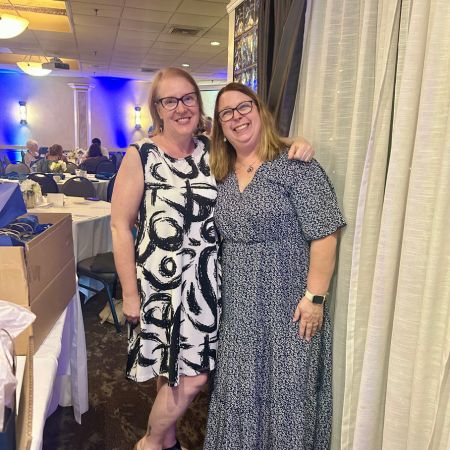The Perks of Being a Co-Teacher
Amber Chandler shares the perks of co-teaching—building connection, balance, and stronger support for every student in the classroom.

Share
September 12, 2025
Amber Chandler shares the perks of co-teaching—building connection, balance, and stronger support for every student in the classroom.
Share
If I could wave a magic wand, all classes would be co-taught. You might be thinking that co-teaching is only necessary for classes with kiddos who have special needs. I agree 100 percent that a co-teacher is necessary to help neurodivergent students, and those with individualized education plans, as this webinar explains. While that may be the practice, I think we should expand that model with co-teachers for all classes. We could also all use a person to “do school” with. Sure, we have our teacher besties, but as we know, every single class has its own distinct vibe, largely depending on who is in the room, but also influenced by the time of day, proximity to lunch or dismissal, and the dynamic you create. That is where having a co-teacher comes in. It is very hard to create a true learning environment that is a caring community without having enough of you to go around. This isn’t a new topic for me; creating caring communities is sort of my thing! When we have co-teachers, we are able to make sure all students get the little (or a lot) extra that they need. Again, this is not a special education thing. This is a matter of truly caring for our students by seeing them, hearing them, and knowing them. Let me explain.
This video on class size demonstrates how difficult it is to make sure all students are getting the help they need with larger class sizes. I’ve taught for 25 years, and I unequivocally believe that class sizes of 18-20 students is ideal, 21-25 manageable, and 26 or more (without a co-teacher) is practically educational malpractice. We are preached at continually to make our classes more engaging, more student-centered, all while maintaining structure and order. And don’t forget to raise your test scores!
The sheer presence of another person in the room doesn’t always work, as anyone who has had a bad co-teacher or disinterested adult can tell you. My co-teacher and BFF, Laura, is my right hand. She is technically a special education teacher, but you’d never know it from the interactions she has with our class. She greets sporty kiddos with questions about their games and whether they have heard about the last trade. She’s a die-hard Bills fan, and around here, that is a conversation starter. We have worked out over the years, though tacitly, because we have never verbalized this, but we divide up the kiddos to make sure they are all “seen” every day. We make sure that a student doesn’t leave our room without a kind or interested interaction with one of us. All students benefit, but for those who are experiencing trauma, poverty or discrimination, it is critical to have a relationship with a caring adult in the school, as this article by Laura E. Hernández, Linda Darling-Hammond and Natalie Neilson explains. Two teachers are a good safeguard against students slipping through the cracks.

When students want or need help, they will try to get it until they go unnoticed or disregarded. This is especially true for students who are shy, anxious or neurodivergent. It may take every ounce of will for them to seek help in the first place, but these students are also often the quietist and try to fly under the radar. Laura and I divide and conquer when we are checking for understanding. For example, when our students are writing, we go into Google Classroom and check their progress. I start at the beginning of the alphabet, and she starts at the end and works backward, until we meet in the middle. We usually type notes to the students, and even those who struggle will reply within the comments section.
Much of our class is interactive and takes the form of pseudo-Socratic seminars called “rotating chairs.” I talk about the importance of flexible seating that we have for social communication. There are always some students who love to jump in and talk, but others are too nervous. When that is the case, Laura will often sit down with students as they prepare and “rehearse” what they might say. This would never happen if I were the only teacher in the classroom; having a second person allows us to pull those quiet kiddos along, and because they are the ones who tend to go unnoticed, they are finally heard at these moments.
For us though, the most important aspect of our co-teaching is that between the two of us, we have a half a century of experience with kiddos; and in every class, we are able to get to know our students. We do this through a lot of day-to-day things, and we aren’t afraid to make it awkward in our attempts to connect with kiddos. One thing we believe is that if an assignment is worth doing, then we should do it too. This way, our students can see us in our vulnerability, and they become more comfortable with us. The Playlist assignment, which is always the first assignment we do, is a perfect example. Here’s mine, and here’s Laura’s. Between the two of us, we have a pretty good track record of connecting with kiddos so they can become known in the way that is so beneficial for all of us.

The other aspect of “being known” is about our relationship as friends and teachers. Teaching is a hard, isolating and deeply emotional experience, and to have someone literally by your side is the best thing that has ever happened in my teaching career. Laura can finish my sentences. She passes out papers because I lose my train of thought when I walk and talk. When I have needed her, she has completely stepped in without a thought because she is my best friend but also because we co-teach. It isn’t my class or hers. When my dad died, I missed the end of the school year, and Laura did all of our grades and shut down our classroom. I didn’t even think about it. There was no worry because she always had my back personally, but it cannot be underemphasized that having a person to help you professionally is one of the greatest gifts.
If you have any chance to have a co-teacher, I highly recommend it. If you have one iffy experience, don’t let it shade your opinion.
I do have a few notes for any administrators out there who make decisions about things like this. First, don’t break up partnerships that work. Too often, an amiable person like Laura would get bounced around from co-teacher to co-teacher, never allowing her to learn the curriculum deeply. Luckily, we are the dynamic duo that no one has tried to mess with! Another note for everyone is this: We are co-teachers; I am not the “main teacher.” If you have a co-teacher, it is crucial to plan together and to work out the kind of student-facing relationship you want to have. What I mean by this is that I had another special education co-teacher who was way better at discipline than I was, so that is what he focused on. He made better review games too. He didn’t love being the “sage on the stage,” but he was awesome at interrupting me when I was going too fast, with “Professor Chandler, I don’t know what you are talking about,” so I could slow down.
If you have any chance to have a co-teacher, I highly recommend it. If you have one iffy experience, don’t let it shade your opinion. There is an amazing thing that happens in a classroom with two teachers who are deeply vested in the success of all the children in the room, not just “their kids.” It has enhanced my teaching, afforded me a co-conspirator in some really fun (and funny) experiences with our students; and, of course, it is invaluable to be known. I’d love to hear about your co-teacher too!
Empower your teaching with effective strategies and tools designed to support the whole student. This collection features insightful webinars and blogs covering student well-being, creating positive school environments, and fostering inclusive classrooms.
